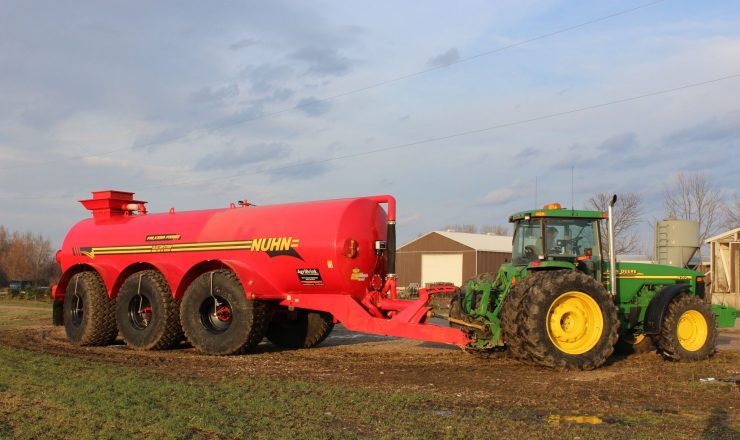James Morgan Ontario, Prescott-Russell AgriBrink, Ontario Soil and Crop Improvement Association, soil, soil compaction, tire pressure adjustment systems
Tires may be full of light air, but that rubber is holding up a lot of heavy equipment, and that can harmfully compact the soil underneath and have damaging effects on farmland.
Farm organizations and businesses are trying to reduce the impact of soil compaction through research, education, and product development.
Adjusting tire pressure to reduce soil compaction is a logical solution but doing it easily and efficiently is a challenge. AgriBrink is a leading Ontario producer of a tire pressure adjustment system that allows farmers to adjust tire pressure quickly. The AgriBrink device has been found to give a four per cent preventative yield loss, improve tire lifespan by 20 per cent, and reduce fuel costs by 15 per cent, in addition to offering better protection of the soil structure.
The origins of AgriBrink go back to 2009 when Wellington County pork producer Jake Kraayenbrink got the idea after discussing it with other farmers and experts at the Ontario Ministry of Agriculture, Food, and Rural Affairs (OMAFRA). Years of experimentation began, which led to the establishment of the company using tests and technologies found in Europe.
“We learned an awful lot,” said Kraayenbrink.
Finding suppliers of parts was difficult in Canada, and Dutch experts suggested adapting similar technologies used by the trucking industry to adjust tire pressure.
“Never did I ever think this was something I would get into!” Kraayenbrink said.
Initially, farmers were frustrated about the time it would take to adjust tire inflation. By 2010, Kraayenbrink, local truck mechanic Steve Bailey, and Professional Engineer Maurice Veldhuis were able to get the process down to as little as 20 seconds.
“That was huge,” he said.
AgriBrink’s equipment has been showcased at Canada’s Outdoor Farm Show near Woodstock and is now being sold across Ontario and Europe. Universities and customers in Denmark, the Netherlands and Switzerland have purchased and used units in their soil compaction research. Kraayenbrink estimates approximately 200 units have been sold so far and six of them were sold to farmers in Eastern Ontario. All of them are manufactured by his family on their farm in Mapleton Township, northwest of Guelph.
In 2011, Kraayenbrink won the Premier’s Award for Agri-Food Innovation Excellence because of the development of the tire pressure adjustment system.
Eastern Ontario
Reducing tire pressure is a big factor in reducing soil compaction, according to Colleen Acres, the Regional Program Lead for Eastern Ontario with the Ontario Soil and Crop Improvement Association. (OSCIA). She said the evidence was apparent at a soil compaction day held by the Dundas County OSCIA in 2019 near Winchester where sensors were placed in the ground where a variety of equipment was driven or hauled over the surface.
Acres said the effects of soil compaction vary, depending on the type of soil.
“Different soil types have different degrees of soil compaction rates.”
Heavy clay soils are at more risk of negative impacts from compaction. In Prescott County, soil types classified as Allendale Fine Sandy Loam, Bearbrook Clay, Bearbrook Silty Clay Loam, Bainsville Fine Sandy Loam, Lyons Loam, North Gower Clay Loam, and St. Rosalie Clay have the highest potential for soil compaction.
According to Acres, custom manure application services often offer measures to reduce soil compaction in their advertising to customers. In addition to technologies such as those offered by companies like AgriBrink, low pressure radial tires, or no tires at all on farm equipment, offer ways of saving the soil.
“We’re seeing a lot more tracks on grain buggies and heavy loader tractors.”
Acres said there is also an agronomic solution to soil compaction. The use of cover crops such as turnips help break up the soil and improve filtration due to the size of their root systems.
“There’s more than just one tool in the toolbox.”
James Morgan
James Morgan is a freelance contributor. He has worked for several print and broadcast media outlets. James loves the history, natural beauty, and people of eastern Ontario and western Quebec.

